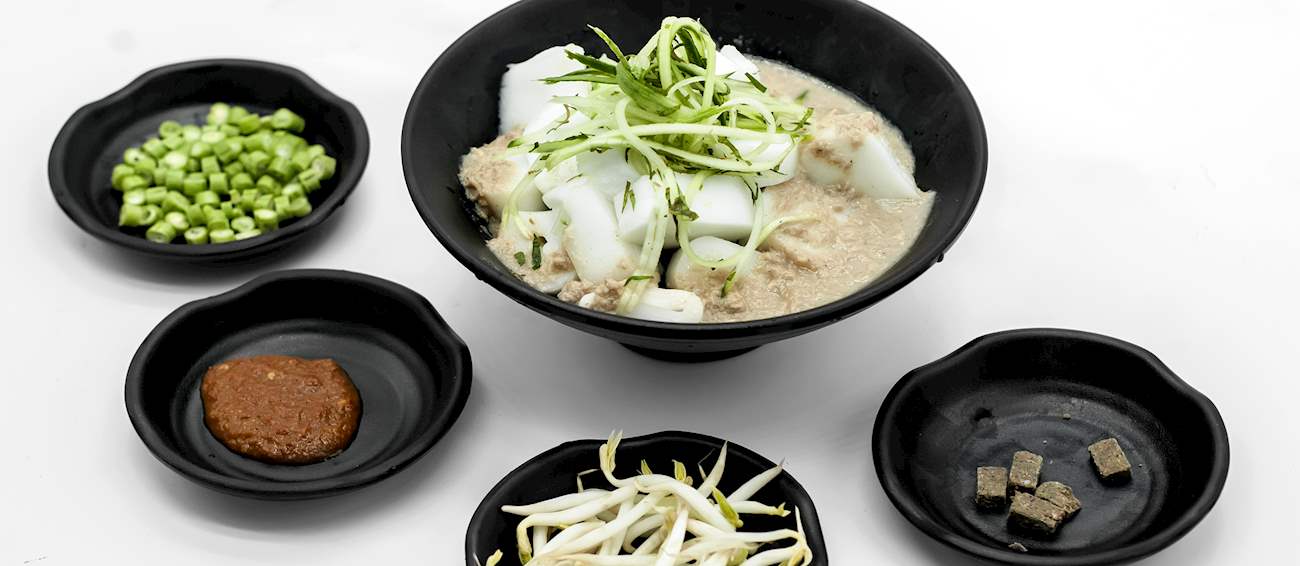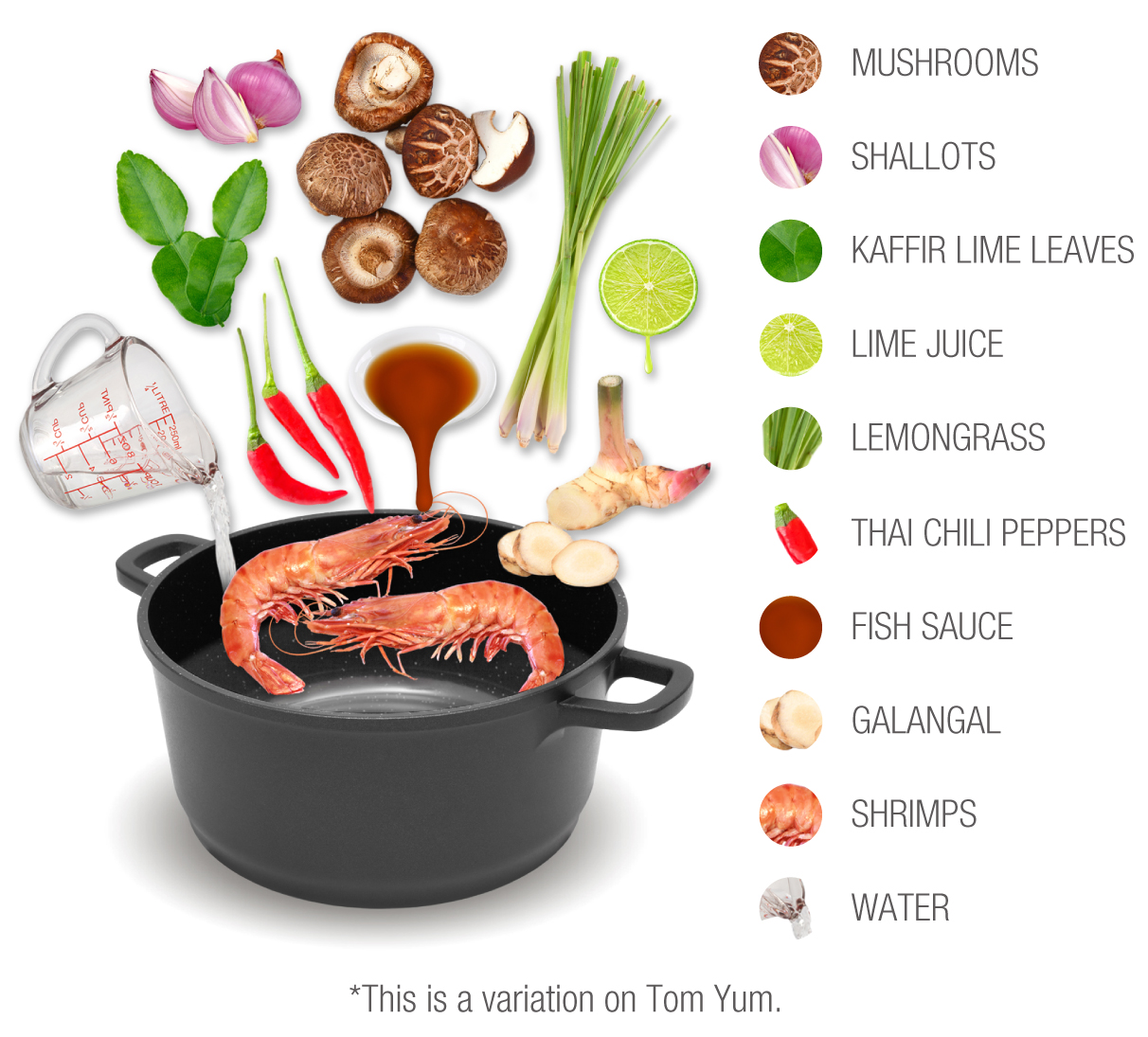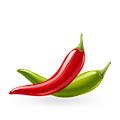MAIN INGREDIENTS
Tom Yum is one of the best known Thai dishes, a spicy, sour, and aromatic soup that is traditionally served with rice. It consists of shallots, lemongrass, fish sauce, minced fresh ginger or galangal, shrimps, mushrooms, kaffir lime leaves, lime juice, and minced Thai chili peppers.
Usually served as an appetizer, tom yum is traditionally garnished with coriander leaves on top. Due to its popularity, different versions of the soup started to appear over the years, such as tom yum gai, with added chicken, and tom yum talay, with mixed seafood.
VARIATIONS OF Tom yum
MOST ICONIC Tom yum
View moreMAIN INGREDIENTS
Traditionally associated with the regions of Kelantan and Terengganu, this flavorful Malaysian soup consists of rolled rice noodles served in a creamy fish broth. The noodles are prepared with a thin rice flour batter that is poured on a flat surface, steamed, and then rolled and sliced into bite-sized pieces.
The broth served alongside the noodles is made with coconut milk and creamy fish paste, and is usually seasoned with ginger, shallots, and garlic. The whole dish is complemented by various vegetables such as sliced cucumbers or green beans and is usually accompanied by spicy sambal.
MAIN INGREDIENTS
The term canh chua cá encompasses various fish-based Vietnamese soups that are characterized by their combination of sweet, spicy, and sour flavors. The soups are usually made with a tamarind-based broth, and they typically include chunks of pineapple, tomatoes, okra, bean sprouts, or other vegetables.
Most varieties are prepared with catfish, but some versions include carp, snakehead fish, eels, or salmon. These soups are usually topped with cilantro and served with rice on the side.
MAIN INGREDIENTS
The perfect blend of spicy, sweet, savory, and umami flavors, penang laksa is a popular Malaysian street food, originating from the north-western state of Penang. This hearty noodle soup is made with poached mackerel (or sardines), tamarind, lemongrass, and chili peppers as the base ingredients.
Other commonly used garnishes include ginger flower buds, pineapple slices, onions, mint, and shrimp paste (hae ko). But, regardless of all the specific recipes, the result is always a rich and strong-flavored dish that has earned the adoration of both locals and travelers alike.
As the name implies, this laksa variety hails from the Katong neighborhood of Singapore's Central Region. It is based on a spicy, shrimp-infused broth that's flavored with coconut milk and a special laksa paste consisting of dried shrimps, herbs, and spices.
Other elements include thick rice noodles and a variety of condiments and toppings such as shrimps, fishcakes, cockles, tofu puffs, fish balls, spicy sambal sauce, or coriander. The noodles in Katong laksa are always cut into smaller pieces, and when served, each bowl comes with a spoon.
Assam laksa is a traditional fish-based sour noodle soup. It is the one of the numerous varieties of laksa, popular noodle soups widespread throughout Southeast Asia. The dish consists of rice noodles, shredded fish, and sliced vegetables, most commonly cucumber, onion, and lettuce.
It has a distinctively tangy taste, which is attributed to tamarind, the sour ingredient generously used to spice the dish. The exact origin of the dish is unknown, but it is believed that it has originated in the coastal areas of Malaysia among the local fishermen who assembled the dish out of available ingredients.
MOST ICONIC Assam laksa
View moreTekwan is a traditional fish ball soup. The essential component of the dish are tekwan fish balls, from which the dish derives its name. Usually made with fish paste, tapioca, and flour, they are boiled or fried before being added to the soup. The broth is usually fish or shrimp-based, and mushrooms, dried lily flowers, slices of jicama, garlic, and scallions are subsequently added and served with tekwan.
Some varieties of the dish also include vermicelli noodles and other vegetables. The origin of tekwan is believed to be the city of Palembang, located in South Sumatra, from where this delicious soup has spread across the country. It is usually found on the menus of Indonesian restaurants, and it is commonly served at warungs - traditional Indonesian street food stalls.
MOST ICONIC Tekwan
View moreMAIN INGREDIENTS
Canh chua is a popular Vietnamese soup originating from the Mekong Delta region. It's characterized by its contrasting flavors - sour, sweet, and savory. The soup incorporates ingredients such as seafood (eel, shrimp, snakehead, catfish), tomatoes, okra, pineapple, tamarind, bean sprouts, and fresh herbs with a tangy flavor.
Traditionally, canh chua is served either with rice vermicelli noodles or with a side of steamed jasmine rice. There are numerous versions of the soup depending on the ingredients used in it - besides fish, it can be made with water spinach, chicken, bamboo shoots, mustard greens, pork, or beef.
VARIATIONS OF Canh chua
MOST ICONIC Canh chua
View moreMAIN INGREDIENTS
Sinigang na hipon is a Filipino shrimp soup characterized by its sour and strongly savory flavor. In addition to shrimp, this dish contains a great variety of vegetables, including onions, tomatoes, string beans, banana peppers, water spinach, taro, radishes, and ladies’ fingers, with ginger and fish sauce being added for extra flavor.
Sinigang’s signature sour flavor comes from tamarind, but other natural souring agents, such as green mango, guava, santol, calamansi, bilimbi, or pineapple can also be used. Sinigang na hipon is very popular in the Philippines, where it is considered a homemade specialty.
The main elements of this Singaporean soup include a flavorful fish-based broth that is enriched with milk and spices, bee hoon noodles (rice vermicelli), fried or boiled fish heads or fish slices, and mustard greens. Garoupa, snakehead, pomfret, and batang are the most common types of fish used in this dish, and the fish stock is occasionally flavored with brandy or rice wine.
This hearty soup is a classic hawker-style dish that is usually served garnished with fresh scallions. In 2010, CNN mentioned this soup as one of the forty must-try dishes in Singapore.
MOST ICONIC Fish soup bee hoon
View moreTasteAtlas food rankings are based on the ratings of the TasteAtlas audience, with a series of mechanisms that recognize real users and that ignore bot, nationalist or local patriotic ratings, and give additional value to the ratings of users that the system recognizes as knowledgeable. TasteAtlas Rankings should not be seen as the final global conclusion about food. Their purpose is to promote excellent local foods, instill pride in traditional dishes, and arouse curiosity about dishes you haven’t tried.























